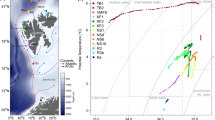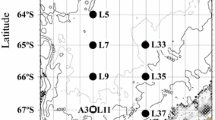Abstract
The distribution of copepod species and their nauplii was studied in a narrow, blind channel on an overwash mangrove island offshore of Belize. Copepodids were sampled with a pump at five stations across the channel during a diel cycle. Diel changes of copepodid stages II – VI were marked by horizontal dispersal of Dioithona oculata, the dominant species, from swarms in the prop roots along the shore during the day to the edge of the prop root habitat at night. Migration of copepodids back to the prop roots appeared to be controlled endogenously because change from a night to a daytime age structure began before first light. Mean copepodid stage at subsurface depths in the channel and prop root edge decreased from 4.2 (with 6.0 = all adults) to 2.9 at predawn to 1.1 during day. The oceanic Oithona nana and O. simplex, and the coastal zone O. fonsecae were evenly distributed with depth and distance from shore during day and night, with avoidance of prop root shoreline during day. These species were much less abundant than Dioithona oculata in the prop roots, but of comparable or greater abundance in the channel. Coastal zone Acartia spinata exhibited evidence of swarming. Nauplii, sampled with a 25μm plankton net, were dominated by harpacticoid (50%) and cyclopoid (34%) nauplii, which generally were more abundant at 1m than at the surface and more abundant at night than the day. Lagrangian current measurements indicated velocities at ebb tide twice those of flood tide (1.9 vs. 0.8 cm s−1) and a minimal residence time of 5 days, which could result in advection of D. oculata nauplii out of the Lair Channel before their recruitment into swarms as copepodid stage II. Previously reported maximum swimming speeds of swarming D. oculata copepodid stages (2.0 cm s−1) and greater densities in prop roots and near the benthos may help copepodids avoid advection. The swarming behavior and diel horizontal migration (or dispersal) reported for D. oculata appears analogous to that of limnetic zooplankton, which may swarm among macrophytes along shorelines during the day to avoid visual predators and disperse or migrate away from the shoreline at night.
Similar content being viewed by others
References
Ambler, J.W., 2002. Zooplankton characteristics, proximal cues and proposed advantages. Hydrobiologia 480: 155–164.
Ambler, J. W., F. D. Ferrari & J. A. Fornshell, 1991. Population structure and swarm formation of the cyclopoid copepod Diothona oculata near mangrove cays. J. Plankton Res. 13: 1257–1272.
Ambler, J. W., F. D. Ferrari, J. A. Fornshell & E. J. Buskey, 1999. Diel cycles of molting, mating, egg production and hatching in the swarm forming cyclopoid copepod Dioithona oculata. Plankton Biol. Ecol. 46: 120–127.
Buskey, E. J., J. O. Peterson & J. W. Ambler, 1995. The role of photoreception in the swarming behavior of the copepod Dioithona oculata. Mar. Freshwat. Behavior Ecol. 25: 1–13.
Buskey, E. J., J. O. Peterson & J. W. Ambler, 1996. The swarming behavior of the copepod Dioithona oculata: in situ and laboratory studies. Limnol. Oceanogr. 41: 513–521.
Ferrari, F. D. & J. W. Ambler, 1992. Nauplii and copepodids of the cyclopoid copepod Dioithona oculata (Oithonidae) from a mangrove cay in Belize. Proc. Biol. Soc. Wash. 105: 275–298.
Ferrari, F. D. & T. E. Bowman, 1980. Pelagic copepods of the family Oithonidae (Cyclopoida) from the east coasts of Central and South America. Smithsonian Contributions to Zoology 312. 27 pp.
Fornshell, J. A., 1994. Copepod nauplii from the barrier reef of Belize. Hydrobiologia 292/293: 295–301.
Grindley, J. R., 1984. The zooplankton of mangrove estuaries. In Por, F. D. & I. Dor (eds), Hydrobiology of the Mangal, The Ecosystem of the Mangrove Forests. Dr W. Junk Publishers, The Hague: 79–87.
Hamner, W. & J. Carleton, 1979. Copepod swarms: attributes and role in coral reef ecosystems. Limnol. Oceanogr. 24: 1–14.
Jeppesen, E., T. L. Lauridsen, T. Kairesalo & M. R. Perrow. 1998. 5. Impact of submerged macrophytes on fish-zooplankton interactions in lakes. In Jeppesen, E., M. Søndergaard & K. Christoffersen (eds), The Structuring Role of Submerged Macrophytes in Lakes. Springer Verlag, New York: 91–114.
Kjerfve, B., K. Ruetzler, & G. H. Kierspe, 1982. Tides at Carrie Bow Cay, Belize. Smithsonian Contributions to the Marine Sciences 12: 47–51.
Knauss, J. A., 1978. Introduction to Physical Oceanography. Prentice-Hall, Inc., Englewood Cliffs, N.J. 338 pp.
Koltes, K. H., J. J. Tschirky & I. C. Feller, 1998. Carrie Bow Cay, Belize. In Kjerfve, B. (ed.), CARICOMP – Caribbean coral reef, seagrass and mangrove sites, Coastal region and small island papers. UNESCO, Paris 3: 79–94.
Knudsen, M., 1900. Ein hydrographische lehrsatz. Ann. Hydrogr. Mar. Meteorol. 28: 316–320.
McGowan, J. A. & P. W. Walker, 1979. Structure in the copepod community of the North Pacific Central Gyre. Ecol. Monogr. 49: 149–226.
McKinnon, A. D., 1991. Community composition of reef associated copepods in the lagoon of Davies Reef, Great Barrier Reef, Australia. In Uye, S.-I., S. Nishida & J.-S. Ho (eds), Proceedings of the Fourth International Conference on Copepoda. Bull. Plankton Soc. Japan Spec. Vol. 467–478.
McKinnon, A. D. & D. W. Klumpp, 1998. Mangrove zooplankton of North Queensland, Australia. I. Plankton community structure and environment. Hydrobiologia 362: 127–143.
Nishida, S., 1985. Taxonomy and distribution of the family Oithoidae (Copepoda, Cyclopoida) in the Pacific and Indian Oceans. Bull. Ocean Res. Inst. U. Tokyo 20: 1–167.
Robertson, A. I. & S. J. M. Blaber, 1992. Plankton, epibenthos and fish communities. In Robertson, A. I. & D. M. Alongi (eds), Coastal and Estuarine Studies 41, Tropical Mangrove Ecosystems. American Geophysical Union, Washington, D.C.: 173–224.
Sabatini, M., 1990. The developmental stages (Copepodids I – VI) of Acartia tonsa Dana, 1849 (Copepoda, Calanoida). Crustaceana 59: 53–61.
Sabatini, M. & T. Kiørboe, 1994. Egg production, growth and development of the cyclopoid copepod Oithona similis. J. Plankton Res. 16: 1329–1351.
U.S. Naval Oceanographic Office, 1965. Oceanographic Atlas of the North Atlantic Ocean. Section I. Tides and Currents. Washington, D. C., Publication Number 700. 76 pp.
Wüst, G. 1964. Stratification and circulation in the Antillean-Caribbean basins. Vema Res. Ser. 2: 1–201.
Author information
Authors and Affiliations
Rights and permissions
About this article
Cite this article
Ferrari, F.D., Fornshell, J.A., Ong, L. et al. Diel distribution of copepods across a channel of an overwash mangrove island. Hydrobiologia 499, 147–159 (2003). https://doi.org/10.1023/A:1026369214254
Issue Date:
DOI: https://doi.org/10.1023/A:1026369214254




